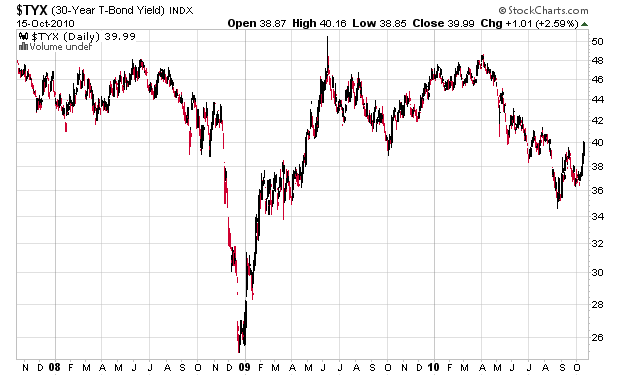With all the talk of the US Federal Reserve performing another round of quantitative easing (which amounts to repurchasing medium and long-dated government debt securities in an attempt to lower long term interest rates and frustrate people into purchasing anything else where they can get a decent yield on cash), the markets have started to get a bit antsy on the macroeconomic front.
Since the strength of the US dollar is a huge global variable, whenever the US Federal Reserve does something, the rest of the world, including domestic US investors, will notice. And indeed, the world has reacted by tanking the currency. More interestingly, however, is the rise in treasury yields (lower treasury prices):
In theory when you have the full force of the US Federal Reserve behind a position (in this case, purchasing government bonds), you try to get out of the way. This time, the market’s reaction appears to be one of indigestion – an exit from bonds. This is very interesting and if the trend continues, will have huge ramifications on investor’s calculations as to what exactly constitutes a “risk free rate”.
It is increasingly clear that US government debt is not as “risk free” as people may think, and this risk should be appropriately adjusted in financial calculations.
The easiest way for an investor to directly take a stake in this (other than buying or shorting treasury futures, which is a relatively trivial transaction to perform) is to buy or sell units in NYSE: TLT, which is an ETF that contains long-dated treasury instruments of 20 years and above. TLT is down about 8% from two months ago, when US Treasury bonds were trading at a local minimum of 3.5%. During the pits of the economic crisis, the US Treasury bond traded as high as 2.5% as investors dove for the safest haven.
A question in the financial markets should now be – exactly how safe is the “safest haven”? If the answer is anything other than US government debt, this would explain the currency exodus.
As a comparison, Canadian long term benchmark yields have generally gravitated down from August – reaching a high of 3.72% in August, and currently trading at 3.45%, and a low of 3.33% seen in late September. Clearly, the crisis hitting the US bond market is not hitting the Canadian bond market, at present.
My perception is that if this is the beginning of a “run” on US long term debt, there will be huge financial ripples in the US marketplace – for example, what do you do when you see a corporate long-term bond trading at a yield of 7%, when the 30-year US government debt is trading at the same yield? We are not there yet, but rising US government bond yields will crush the corporate debt market window that is currently open.
Watch out, because I suspect things are getting exciting again.
